Cholestatin
Table of Contents:
1. What are Phytosterols? A General Introduction
2. The Good and the Bad Roles of Cholesterol
3. The Effect of Dietary Phytosterols en Cholesterol
4. Animal Trials
5. Human Efficacy Studies
6. Different Forms of Phytosterols
7. Recommended Daily Intake
8. Technical Data on Cholestatin
9. References
Degussa BioActives' nutritional products contribute significantly to a healthy
and comfortable life. With our global networking, superior quality and strong
research & development activities, we are well prepared to meet future
challenges in the growing market of nature-based nutraceuticals and food ingredients.
We know that the educated consumer expects nutritionally valuable foods -
foods that are vital to a well-balanced diet and disease prevention -to be
produced under environmentally friendly conditions. We've been responding to
this expectation.
With sales offices in Europe, USA and Asia, we are able to offer our customers
premium service. Our research centers in Freising (Germany); Waukesha, Wisconsin
(USA); and Champaign, Illinois (USA) form the framework for our products and
solutions.
1. What are Phytosterols? A General Introduction
The term "phytosterols" was first used in 1897 for sterols of plant
origin. Phytosterols are cholesterol analogs, which means they have similar
functions but different origins. Cholesterol is found in animals and humans
while phytosterols occur only in plants. Cholesterol is a very important molecule
in animals and humans, serving as a vital constituent of cell membranes and
a precursor to various biomolecules. Phytosterols serve similar functions in
plants.
Phytosterols are found in vegetables and nuts as well as other foods and are
therefore part of our modern day diet but not in the quantities necessary to
exert health benefits. The current western diet is estimated to include 200-300
mg phytosterols per day, while vegetarian and Japanese diets include a larger
quantity, 300 - 500 mg per day1. It is theorized that primitive man's diet
included over 1000 mg per day. It is commonly accepted that approximately 1
g per day is required to have a serum cholesterol lowering effect3. Phytosterol
supplementation is essentially readjusting our daily intake to approximate
that which our ancestors may have experienced.
Phytosterols differ from cholesterol in small but significant ways. The structure
of phytosterols includes some branches that are not present on the cholesterol
molecule.
Due to these structural differences, phytosterols are not well absorbed in
animals or humans. The vast majority of the phytosterols ingested remain in
the gastrointestinal (GI) tract. In healthy humans, absorption is limited to
approximately 5% of the total beta-sitosterol and approximately 15% of the
campesterol ingested. With daily phytosterol intakes of 160 to 360 mg/day,
only 0.3 to 1.7 mg/dL phytosterols are found in the blood. Plasma levels of
phytosterols have been shown to as much as double with supplernentation3'.This
is a small quantity compared with 240 mg/dL greater, cholesterol levels that
will be present in hypercholesterolemia. Phytosterols are eliminated from the
body more rapidly than cholesterol via the biliary route.
The majority of phytosterols available today are derived from vegetable oil
processing. Crops primarily processed for vegetable oil like canola, cottonseed,
corn and soybean, are major sources of phytosterols. An alternative commercial
source is tall oil, a by-product of paper mills.
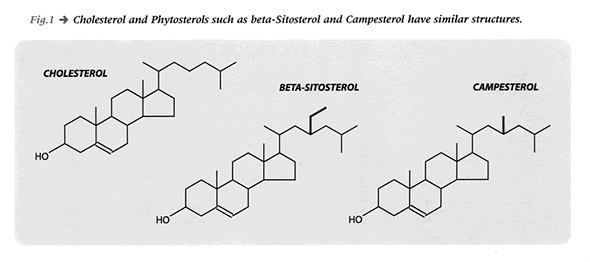
2. The Good and the Bad Roles
Cholesterol is essential for life in animals and humans. A correct ratio of
cholesterol to phospholipids is crucial for cell membrane fluidity. Cholesterol
is also important due to its role in the synthesis of hormones, bile acid,
and vitamins. Various active biomolecules are made in the body using cholesterol
as a raw material. Cortisol, testosterone, estradiol and progesterone are examples
of steroids made from cholesterol.
Unfortunately, cholesterol can also work against us. Stroke, heart attack,
hardening of the arteries and even a form of gall stones are attributed to
an excess of cholesterol.
Cholesterol is implicated in the deposition of plaque in arteries. Nutritional
deficiencies and sudden intense stress in which the brood vessels don't have
time to dilate are examples of conditions that can result in small tears in
the lumen of the artery. A possible mechanism for the progression of atherosclerosis
is that the body's natural response to these small tears is to release collagen
into the blood stream to repair the tear. White blood cells, with oxidized
cholesterol attached are also incorporated into the repair, causing the build
up of what is called soft plaque. The presence of soft plaque results in a
characteristic "fatty streak" which runs along the interior of an
artery. This fatty streak is composed of smooth muscle cells filled with cholesterol
and macrophages, which are trying to remove the cholesterol.
The next stage of atherosclerosis, fibrous plaque, involves the addition of
proteins and other substances to the fatty streak. As the deposition increases
in size, it begins to project into the artery. When occlusive atherosclerotic
plaque is present, patients can experience effort angina claudication in which
they experience pain or exhaustion during what should be moderate exertion.
Atherosclerotic plaque can rupture and cause clotting which, depending on the
location of the rupture, may cause myocardial infarction or heart attack,
coronary death, stroke, unstable angina, or critical leg ischemia.
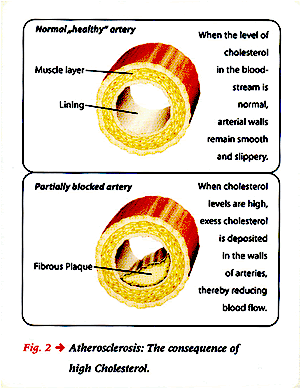
Cholesterol does not just float freely through our blood stream. It is transported
by lipoproteins. There are different lipoproteins, classified by density and
they have different functions (Figure 3).Very Low Density Lipoprotein (VLDC)
is a precursor to Low Density Lipoprotein (LDL). LDL is responsible for transporting
cholesterol to the various tissues within the body. High Density Lipoprotein
(HDL) is involved in the reverse transport of cholesterol, that is, it carries
excess cholesterol from tissues within the body, including veins and arteries,
back to the liver where it can be disposed of.
The primary villain in atherosclerosis is LDL cholesterol because it is believed
to be more likely deposited on the walls of arteries. LDL cholesterol is harmful
after being attacked by free radicals, homocysteine or other unstable molecules.
The quantity of oxidized cholesterol in plaque is an indication of the vulnerability
of that plaque to rupture.
 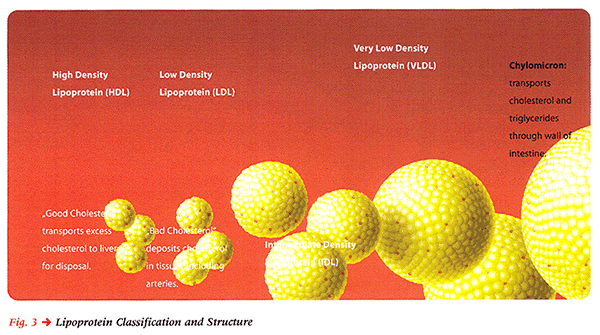
HDL cholesterol is considered "good" cholesterol. Low levels of
HDL are directly related to increased incidence of heart disease. Reverse cholesterol
transport describes the function of HDL cholesterol. This is the removal of
cholesterol from tissues other than liver cells and the delivery of the cholesterol
to the liver and other tissues that can metabolize the cholesterol7.
One predictor .of coronary heart disease (CHD) in women, according to one
study", was the ratio of total cholesterol to HDL. If a woman's total
cholesterol is about four times or so of her HDL level, her risk of heart disease
skyrockets to up to five times that of her normal counterpart.
Guidelines for acceptable levels of these forms of cholesterol are presented
in Table1
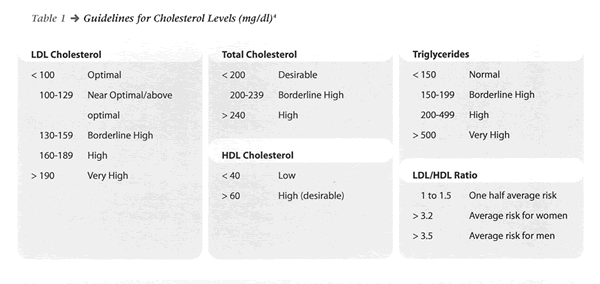
3. The Effect of Dietary Phytosterols On Cholesterol
As early as the 1930's it was shown that serum cholesterol levels could be
effected by phytosterol supplementation work in the 1950's confirmed the ability
and numerous efficacy studies since, in animals and humans, have proven that
phytosterols are highly effective in lowering cholesterol levels.
Cholesterol in the GI tract can be of two sources; dietary which is in the
foods we eat and endogenous which is manufactured by our bodies, Both are excreted
into the intestines from the gall bladder with bile after synthesis or absorption,
Without intervention, most of this cholesterol will be reabsorbed in the intestines.
For cholesterol to be absorbed, it must be incorporated into micelles and transported
to the inner lining of the GI tract.
Phytosterols are poorly absorbed so the bulk of ingested phytosterols remain
in the GI tract. Phytosterols decrease the transport of cholesterol to absorption
sites by excluding it from the transport mechanism. There are two proposed
mechanisms by which phytosterols decrease serum cholesterol levels. Both mechanisms
are based on the similar physical and chemical properties of phytosterols and
cholesterol.
One mechanism is believed to work through precipitation or crystallization
of cholesterol and phytosterols. As the concentration of cholesterol and/or
phytosterols increases in the intestine, both become less well dissolved
and begin to drop out of solution in crystalline form. Crystalline cholesterol
cannot be absorbed. Since cholesterol is the only one absorbed to any great
extent, its absorption is dramatically reduced.
In the second proposed mechanism the phytosterols are believed to compete
with the cholesterol for transportation to the wall of the intestine, the brush
border, where absorption occurs2. Because cholesterol is less soluble in water
than oil, it has to be transported to the site of absorption in micelles. Micelles
are formed from bile salts, phospholipids, tri, di- and mono- glycerides, fatty
acids, free cholesterol and fat soluble micronutrients. Phytosterols are even
less soluble in water than cholesterol so they have a stronger affinity for
the micelles. This “competition" for the micelles prevents the cholesterol
from reaching the absorption site.�
4. Animal Efficacy Studies
More than 50 years of research has proven that phytosterols are highly effective
in lowering cholesterols levels hi different animals.
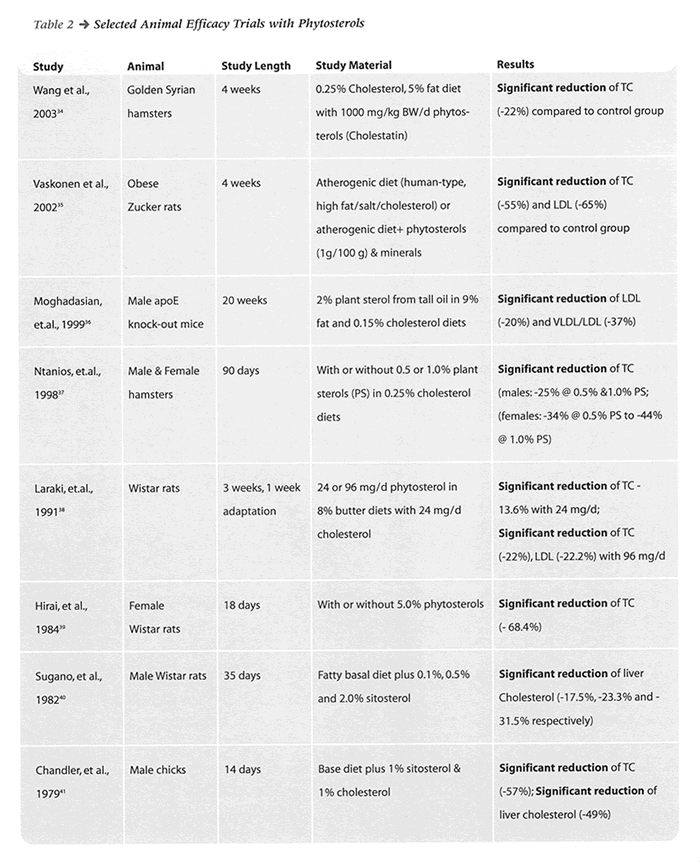

A 2003 study by Wang et al. investigated the effects The phytosterol group
was fed the control diet with of Cholestatin on the lipid levels in Syrian
Golden hamsters. The hamsters were fed a control diet that contained 0.25%
cholesterol and 5% total fat with a contained 0.25% cholesterol and 5% total
fat with a polyunsaturated to saturated fatty acids ratio of 0.4. The phytosterol
group was the control diet with addition of Cholestatin (Degussa BioActives,
1,000 mg/kg). Supplementation with Cholestatin prevented a rise in plasma cholesterol
levels that would be expected with a cholesterol enriched diet (Figure 4).
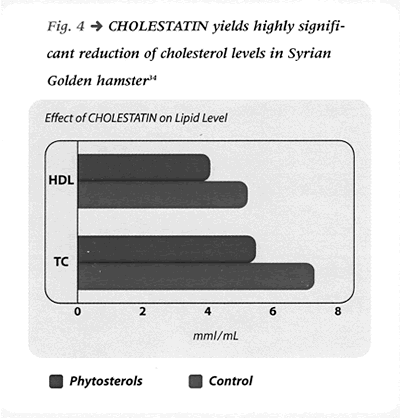
A statistically significant difference was found between the plasma total
and HDL cholesterol levels in hamsters supplemented with phytosterols compared
to those that were not. It is important to note that in the hamster model for
cholesterol studies, the hamsters carry over 75% of plasma cholesterol as HDL
cholesterol. While in humans a decreased HDL is not desired and does not occur
as a result of phytosterol supplementation, reduction in HDL cholesterol in
hamsters is a desired response to phytosterol supplementation.
Vaskonen et al., 2002, induced severe hypercholesterolemia in hypertensive
rats which generally have low cholesterol by feeding a typical human diet;
high fat, high cholesterol and high salt. The increase in total and LDL cholesterol
could be attenuated by the addition of phytosterols and minerals, Animals supplemented
with phytosterols and minerals showed an increase in total and PDL cholesterol
but the increases were only 45% and 35% of that seen in animals not supplemented.
Phytosterols and minerals also protected against vascular and renal damage
compared to animals fed only the human type diet.
Moghadasian et al., 1999, concluded From their study with mice prone to atheriosclerotic
lesions that supplementation of a cholesterol enriched diet with phytosterols
lowers plasma cholesterol levels and slows progression of atheriosclerotic
lesions. The phytosterols used in this study were derived from pine trees but
chemically, there is no difference in the four primary phytosterols, regardless
the plant from which they were extracted. While the control mice developed
plasma cholesterol levels of 42 mmol/L, the phytosterol treated mice only developed
plasma cholesterol levels of 26.6 mmol/L; 36.7% lower.
Male and female Golden Syrian hamsters (n=120) studied by Ntanios et al.,
were fed a diet with 0.25% cholesteroP. While the control group was only fed
the base diet, four other groups were fed the base diet with 1) 0.5% tall oil
phytosterols, 2) 1.0% tall oil phytosterols, 3) 0.5% soybean phytosterols or
4) 1.0% soybean phytosterols. The results of this study showed that both tall
oil phytosterols and soybean phytosterols were able to reduce cholesterol levels
when compared to the control group. At 0.5% soybean and tall oil phytosterols
decreased cholesterol levels by -30% and -1 5% respectively when males and
females were considered together. At 1.0%, soybean and tall oil phytosterols
decreased cholesterol levels by -34% and -31 % respectively when males and
females were considered together. It is interesting to note that at the lower
concentration, soybean derived phytosterols were more effective in lowering
total cholesterol (Figure 5).
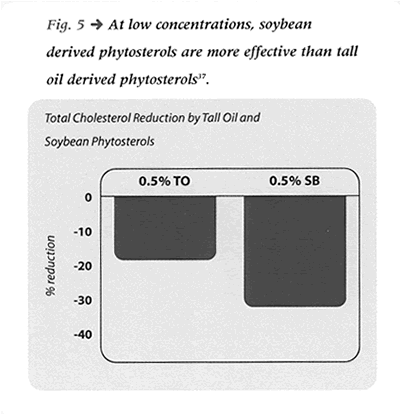
Both sources of phytosterols contained essentially the same amount of beta-sitosterols.
Tall oil phytosterols contained approximately 20% sitostanol while soybean
phytosterols contained 4% more campesterol and 15% more dihydrobrassicasterol.
In a study by Laraki et al., 1998, adult Wistar rats (n=48) were assigned
to one of four groups and fed either 1) basal diet plus 12 mg/d cholesterol,
2) basal diet plus 24 mg/d cholesterol, 3) basal diet, 24 mg/d cholesterol
and 24 mg/d phytosterols or 4) basal diet, 24 mg/d cholesterol and 96 mg/d
phytosterols. The animals were kept on their respective diets for three weeks
after which Laraki et al., found that when compared to the low cholesterol
group (l),the high cholesterol group (2) had 37% higher total cholesterol and
56% higher LDL cholesterol. Having been fed the same high cholesterol diet
plus 24 mg/d phytosterols, group 3 had a total cholesterol level that was 13.6%
lower than group 2. Group 4, having received 96 mg/d phytosterols had total
and LDL cholesterol levels 22% and 22.2% lower than group 2 respectively. In
this study phytosterols were shown to effectively reduce cholesterol levels
even when consumed with a diet that contained cholesterol.
Three groups of Wistar rats (n=12) were fed a diet containing 1.0% cholesterol
for 18 days3? In addition to the standard cholesterol containing diet, one
group of the rats was supplemented with 5.0% phytosterols. In a fashion similar
to previous studies, Hirai et al, 1984, found that the total cholesterol in
the phytosterol supplemented group was greatly reduced (-68.4%) from the total
cholesterol levels found in the non-supplemented animals. Reductions in LDL
and VLDL were also associated with phytosterol supplementation.
Sugano et at., 1982, showed that dietary supplementation for 35 days with
beta-sitosterol was shown to greatly reduce the amount of cholesterol in the
livers of male Wistar rats fed a diet including 10% butter fat. Levels of 0.1%,
0.5% and 2.0% sitosterol resulted in decreases of 1 7.5%,23.3 % and 3 1.5 %
respective1 y. In the same study it was shown that JAC ddy mice could have
a 54% decrease in liver cholesterol when fed a similar diet with 0.5% sitosterol.
In a study by Chandler et al., 1979, to examine the effect of beta-sitosterol,
male white leghorn chicks were given either a base diet or base diet with T.O%
cholesterol for 14 days with 1.0% beta-sitosterol". Results showed a significantly
lowered liver and plasma cholesterol in the subjects supplemented with beta-sitosterol
and cholesterol. The lowest levels were found in those subjects given both
cholesterol and beta-sitosterol. This "synergistic" effect is due
to the down regulatory effect that dietary cholesterol has on cholesterol synthesis.
A '1969 shady by Bartov et al., fed a base diet, a base diet plus cholesterol,
or base diet plus cholesterol and phytosterols to chicks for a 14 day period-The
results showed that phytosterol supplementation could prevent a rise in plasma
(1 38 mg/dL v.s.413 mg/dL ) and liver cholesterol levels (4.4 mg/g v.s.32.7
mg/g) that would result from cholesterol supplementation. With 3% phytosterol
supplementation, total cholesterol was 66% lower and liver cholesterol was
86% less than the cholesterol only group.
Best and Duncan, 1958, fed male Holtzman rats a base diet of mouse mash, cottonseed
oil and cholesterol. Groups of rats on this diet were supplemented with free
sitosterol and sitosterol esters. Both the free sitosterol and sitosterol esters
decreased liver cholesterol levels. While the sitosterol esters did decrease
liver cholesterol levels, the palmitate and proprionate esters were not as
effective as the free sitosterol. The authors postulated that this was due
to the rate of hydrolysis of the esters.
Peterson et al., 1954, performed a six week feeding study using 3 week old
chicks to examine the effects of phytosterols on a diet containing cottonseed
oil and free and esterified cholesterol. Cholic acid supplementation dramatically
increased plasma cholesterol levels when administered in the absence of phytostero1s.
Phytosterols were able to counter-act the effect of the cholic acid and when
administered in the absence of cholic acid, phytosterols decreased plasma and
liver cholesterol levels via interference with cholesterol absorption as shown
by feeding radiolabeled cholesterol.
In a study utilizing male rabbits, Pollack, 1953 conducted a 14 day study
of the effect of phytosterols on cholesterol absorption. Rabbits fed base diet
plus cholesterol exhibited elevated blood cholesterol levels and 90% of these
rabbits had evidence of atherosclerosis at the end of the study. Rabbits fed
various levels of mixed phytosterols but no cholesterol, showed no change in
blood cholesterol levels over controls however, this group also showed no evidence
of atherosclerosis. Groups fed cholesterol and phytosterols (3,5,6,o r 7 g/d)
showed no evidence of cholesterol induced atherosclerosis.
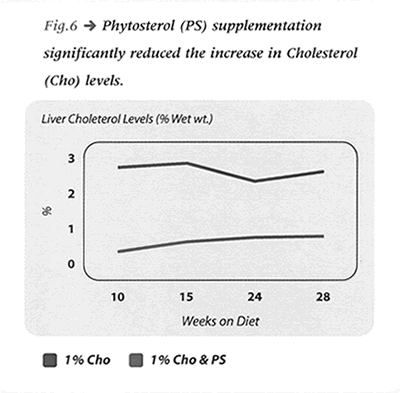
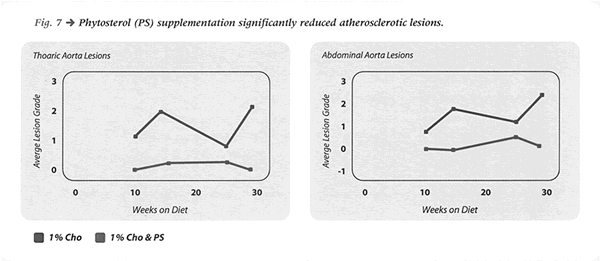
Peterson, et al, 1952, dosed groups of 44 chicks with cholesterol (Cho) or
cholesterol and phytosterols (Cho&PS). Figure 6 shows that the cholesterol
levels in chicks dosed with the combination had significantly lower cholesterol
levels. Levels in the, Cho group were seven times higher than controls while
the Cho & PS levels were only twice as high as the control group.
In addition to the decreased cholesterol absorption atherosclerotic lesions,
while lowest in the control group were significantly lower in the Cho & PS
group than in the group dosed with cholesterols alone (Figure 7).This is true
for lesions formed in the thoracic And abdominal aortas. More recent research
has reinforced this down regulation of atherosclerotic Lesions using mice.
In mice treated with phytosterols , The aortic lesion area was less than half
that found In the non phytosterol treated mice. Additionally, a substantial
reduction in all the lesional components Was observed, indicating a slowing
of atherosclerotic Progression in those animals treated with phytosterols.
This takes on additional significance in light of information that indicates
that coronary atherosclerosis begins at a young age in humans and a number
of
Teenagers and young adults may have the disease but have no symptoms.
�
5. Human Efficacy Studies
Phytosterols have been investigated in pilot studies numerous gold standard
(double-blind, placebo- controlled) human clinical trials. Phytosterols were
administered in functional foods (e.g.spreads, chocolate) or as dietary supplements
(capsule, chewable tablets).
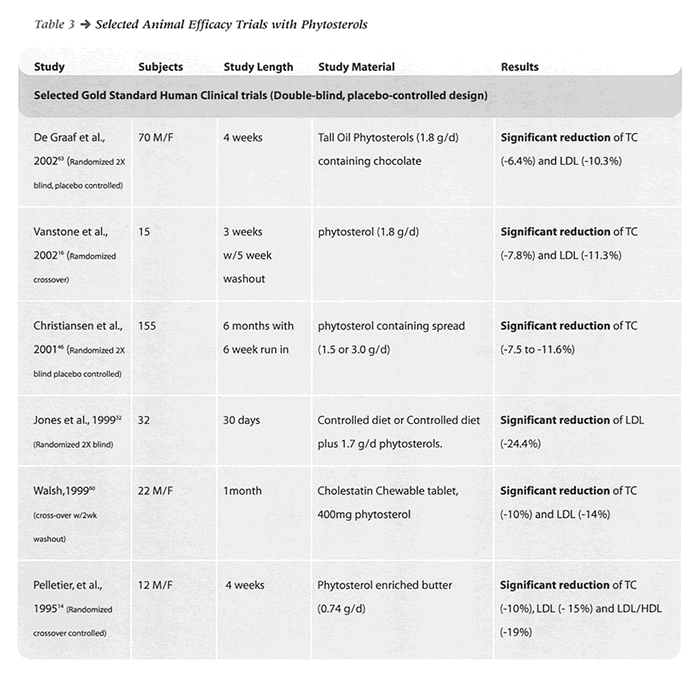
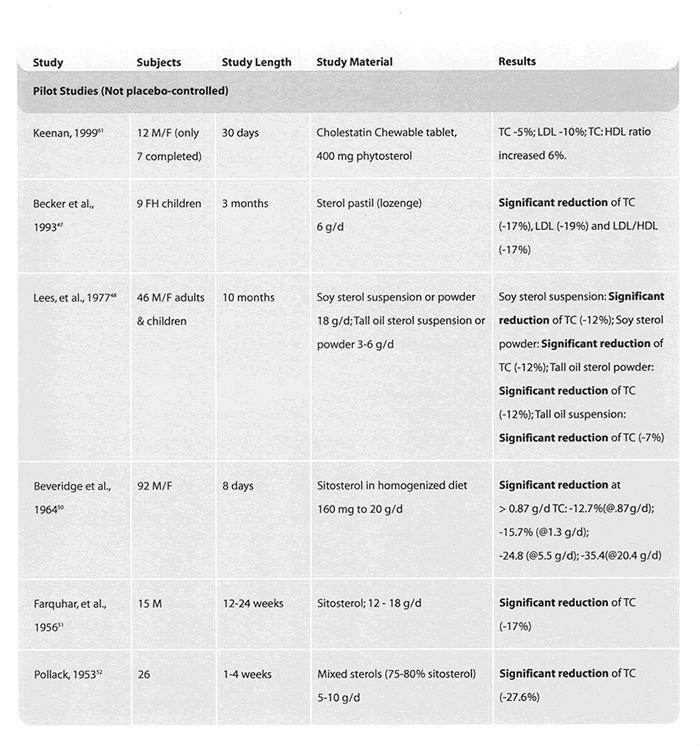
Phytosterols were shown to reduce serum cholesterol in a 2002 study performed
by Vanstone et.al. In randomized , cross over double blind study, fifteen subjects
were fed 1.8g per day with a typical North African diet. Control subjects were
fed the typical North African diet alone. With phytosterol supplementation,
total plasma control levels decreased by 7.8% (P<O.OT) while LDL decreased
by 1 1.3% {P<0.03).
Phytosterols were shown to reduce serum cholesterol in a 1999 study conducted
by Jones et.al. Sixteen hypercholesterolemic male subjects were fed 1.7 g per
day phytosterols in conjunction with a precisely controlled metabolic diet.
Sixteen control subjects were fed the controlled diet alone. Significant cholesterol
reductions were seen in both the control and phytosterol groups however the
phytosterol group showed a significantly larger (P<0.001) decrease. The
greater reduction in LDL due to phytosterols also caused an improved LDL/HDL
ratio in those supplemented with phytosterols (Figure 8).
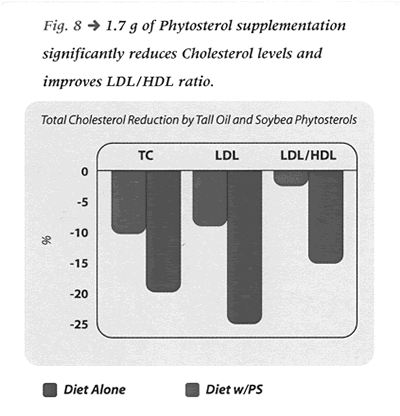
Pelletier, et.aI!4 dosed twelve patients with 740 mg phytosterols pea day
for 28 days (Figure 9). A significant reduction was seen in total cholesterol
(pc.001) and LDL cholesterol (p<0.001), A significant increase in HDL cholesterol
(pe.001) was also observed.
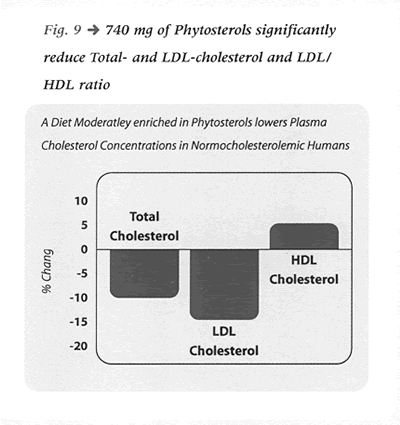
In a 1993 study, Becker et al., dosed a group of children with familial hyper-cholesterolemia
with a sterol pastil (a lozenge) providing 2 g sitosterol per day, LDL-cholesterol
had been reduced by 19.5% at 3 months.
Lees, et al, 1977, studied the effect of soybean and tall oil derived phytosterols
on cholesterol levels in humans. The results of the effort included the finding
that the efficiency of plant sterols can vary greatly from patient to patient,
Soybean sterols as a suspension or powder at 18 g per day decreased serum cholesterol
levels by 12%.Tall oil sterol powder was slightly more effective than tall
oil sterol suspension decreasing Total Cholesterol by 12% and 7% respectively.
A study by Kudchodkar et al, in 1976 showed that phytosterol administration
decreased plasma cholesterol levels on average by 9%. Excretion of cholesterol
increased 34% to 102% indicating that the absorption of cholesterol in the
GI tract was reduced.
Earlier work on phytosterol efficacy that by Beveridge al., 1964, indicated
that statically significant results could be achieved by phytosterol doses
of 0.87 g/d. Ninety-two university students were treated for 7 days with
a run-in diet that had 45% of the total calories derived from butter. Eighty-five
students finished an 8 day treatment with various phytosterol levels added
to the high fat diet. Total cholesterol reductions of 12.7%, 15.7%, 24.8%
and 35.4% were observed at doses or 0.87, 1.3, 5.5 and 20.4 g per day respectively
(Figure 10).
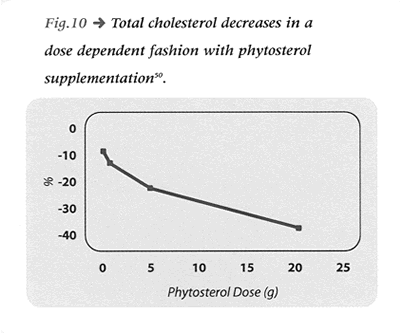
Feeding 12 to 18g of phytosterols per day in three equal doses prior to meals
was found to result in an average plasma cholesterol decrease of 17% in a study
of 15 men who had previously suffered an heart attack. This decreased cholesterol
level was for the six months feeding phase of the study. The plasma cholesterol
level increased promptly after cessation of phytosterol supplementation
Some very early work by Pollack in 1953 reported a significant reduction in
plasma cholesterol levels at doses of 2.5, J.0 and 10.0 g phytosterols per
day. The reduction was reported to be minimal when initial plasma cholesterol
levels were below 200 mg/dL. This researcher also reported a rapid return to
pre-supplementation plasma cholesterol levels after subjects went off of the
supplement. In 1999 two researchers studied the efficacy of an alternative
phytosterol dosage farm, chewable tablets (Cholestatin, Degussa BioActives,
chewable tablets containing 400 mg of soybean derived phytosterols in a tropical
flavored tablet).
Dr. Walsh tested 22 patients for one month, assigning each to either the placebo
or active group. Patients were instructed to eat one tablet prior to each meal
unless the meal was going to be rich in cholesterol in which case two tablets
were taken. After one month, all participants were tested and taken off of
the tablets for a two week wash-out period. Patients were then assigned to
the group they were not in for the first month of the study 0.e. participants
that had been taking placebos were now taking active and vice-versa). Results
from this study indicated a 10% reduction in total cholesterol and a 14% reduction
in LDL cholesterol (Figure 11).
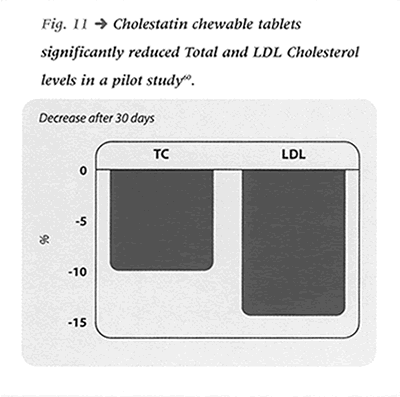
Dr. Keenan, in a less rigorous study, completed a study with seven participants
using Cholestatin Chewable tablets. All participants were assigned to the active
group and were instructed to take one tablet prior to each meal for 30 days.
This study resulted in a 5% decrease in total cholesterol. A result more in-line
with other phytosterol research was the 10% decline in LDL cholesterol levels.
Dr. Keenan did note a 6% decrease in the total Cholesterol to HDL ratio, showing
that the ratio of “bad” to “good” cholesterol had been
effected in a beneficial way.
Recent examples of clinical trials with Phytosterol containing Functional
Foods
A novel dosage form was used to study the effect of phytosterols on plasma
lipids when delivered in dietary chocolate. Seventy subjects were dosed with
either placebo or active for four weeks in conjunction with a low-fat, low-cholesterol
diet. At the conclusion of the study, those who were taking the active exhibited
decreased total (-6.4%) and LDL cholesterol (-10.3%) (Figure 12).
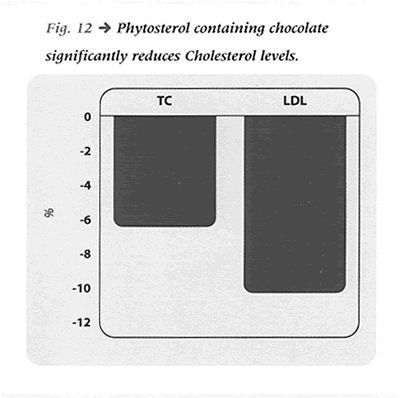
Hypercholesterolemic subjects (n='l55) were given a placebo control spread
for a six week run in period after which the subjects were divided into three
groups (Christiansen et al., 2001).The control group received the placebo spread,
a second group received a spread with 1.5% phytosterols and a third group received
a spread with 3.0% phytosterols. The result of this study was that the groups
receiving either
1.5% or 3.0% phytosterols experienced a significant reduction in Total and
LDL-cholesterol levels. Compared to control, both treatment groups showed similar
reductions leading the researchers to conclude that 1.5g/d phytosterols would
be sufficient to reach the maximum reduction (Figure 13).
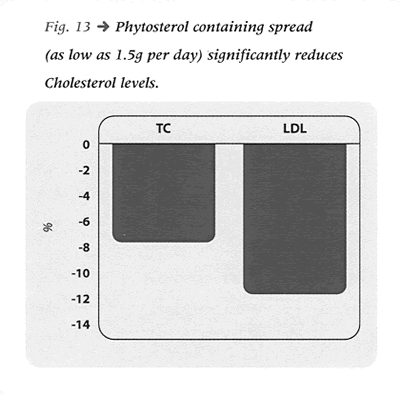
Possible Additional Benefits to Phytosterol Supplementation
While the effects of phytosterols in lowering cholesterol levels are well
studied, there are indications that phytosterols may have additional benefits
in areas such as benign prostatic hyperplasia. In addition, there is evidence
suggesting that beta-sitosterol can suppress in vivo carcinogenesis. Human
prostate cancer cells were studied in vitro comparing the effects of cholesterol
v.s. beta- sitosterol. It was found that the presence of beta-sitosterol decreased
cell growth by 24% and increased the rate at which the cancerous cells died
by four-fold.
There are reports of further beneficial effects of phytosterols, alone and
in combination with other naturally occurring compounds. Phytosterols are discussed
as having possible immunomodulatory and anti-inflammatory activities as well
as being anti-ulcer and anti-diabetic agents. Additional research will be necessary
to substantiate these potential benefits.
6. Different Forms of Phytosterols
There are four forms of phytosterols on the market, all being promoted for
their ability to lower cholesterol 1evels: free phytosterols, free phytostanols,
esterified phytosterols and esterified phytostanols. Phytostanols occur to
a slight extent naturally, but phytostanol products available commercially
are phytosterols that have been hydrogenated to eliminate any double bonds
present in the molecule. Esters of phytosterols and phytostanols are compounds
to which a component of fat, a fatty acid, has been attached to make what is
called an ester.
The cholesterol lowering activity of phytosterol or phytostanol esters results
from the presence of the phytostanol or phytosterol. Upon ingestion, the esters
are hydrolysed, resulting in a free fatty acid and free phytosterol or phytostano119
The Executive Summary of the Third Report of the National Cholesterol Education
Program (NCEP)'" published in May of 2001 recommends phytosterols or phytostanols
at the same dose, 2 g per day.
An association in the United Kingdom, the Institute of Food Science &Technology
published an information statement in June, 2000, stating their belief that
phytosterols and phytostanols are both effective at reducing serum cholesterol.
A dose of approximately 1 g per day, is suggested for both forms. The PDR for
Nutritional Supplements (1st. ed.) has concluded that phytosterols and phytostanols
are equally capable of re-educing cholesterol levels. More recent work has
also shown free phytosterols and free phytostanols to lower LDL cholesterol
in an equivalent fashion. Given that phytosterol and phytostanol esters are
reduced to the free phytosterols and phytostanol after ingestion, it is not
surprising that phytosterol esters and phytostanol esters have also been reported
as equally efficacious.
Not unexpectedly, free phytosterols have been shown to be as effective as
phytosterol esters and phytostanol esters9 These studies allow us to conclude
that all four forms are equal when provided in an appropriate formulation.
In a recent review of the efficacy of the four forms of phytosterols, Dr.
Peter Jones of McGill University, a well known researcher on the effects of
phytosterols on serum cholesterol levels, stated "With the supplementation
of 2 g per day of either sterols or stanols, esterified or free, one can expect
an average reduction of 0.5 mmol/L or 10-15% in LDL reduction."�
7. Suggested
Daily Intake
The average daily western diet is estimated to include 200 to 300 mg of phytosterols.
This is not believed to be a high enough dose to elicit positive health effects.
Recommended daily intake of free sterols range from 1 g per day to 2 g per
day and higher. Efficacy has been shown at the lower doses and a daily dose
of between one and two g is reasonable.
Phytosterols are available in many forms. Functional Foods containing phytosterols
are available (spreads, salad dressings, chocolate) as well as dietary supplements
such as tablets and soft gelatin capsules. As functional foods become more
available, phytosterols may become incorporated into many of our favorite foods.
Work has been done in the R&D Laboratory of Degussa BioActives adding phytosterols
to hamburgers", pizzas and some snack foods without adversely affecting
the taste or texture of the foods. Degussa BioActives continuously works on
future functional food development efforts using free phytosterols.�
8. Technical
Data On Cholestatin
Cholestatin is a mixture of phytosterols. Being derived from a natural source,
the exact ratio of phytosterols present is subject to variation within the
specifications set for the product. The minimum percentages of the various
phytosterols present in Cholestatin, and the minimum total percent of free
phytosterols are shown in Table 4.
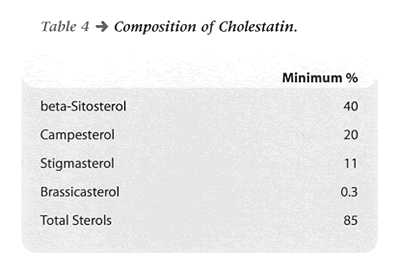
As shown in Table5, the mixture, Cholestatin, has a melting point that is
the same as that reported for pure beta-sitosterol. The Cholestatin melting
point was measured in our lab and is expected to exhibit some variation from
lot to lot as its composition is subject to natural variation.
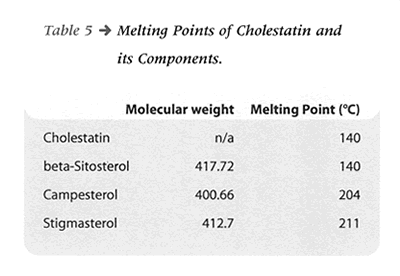
Stability
Phytosterols, like cholesterol, are a hard waxy substance. Properly stored
Cholestatin will maintain its potency for many years. We have tested four-year-old
material and have seen no significant decrease in phytosterol content.
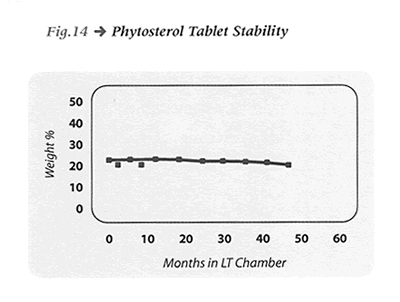
The charts below show composite data for the stability of a Cholestatin product
when placed in environmental chambers for stability testing in accordance with
U.S. Pharmacopeia guidelines.
Long term (LT) stability testing is run at 25 c and 40% relative humidity.
Under these conditions, Cholestatin was shown to maintain its potency for the
duration of the test (48 months).
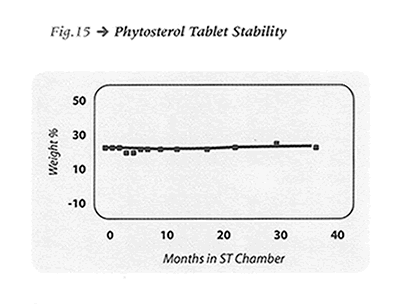
Short term (ST) stability tests are run at a higher temperature (40 "C)
and higher relative humidity (60%) to pose a more severe challenge to the product
being tested. The same phytosterol tablet as above, also maintained phytosterol
potency during the 36 month duration in the short term stability test.
As stated previously, phytosterols are structurally related to cholesterol
and when they degrade, products similar to the products of cholesterol degradation
are produced. Primarily, oxides are formed. Phytosterol oxides have been identified
in foods of plant origin". Conditions that cause cholesterol in food to
oxidize; high temperature, exposure to light, ionizing radiation, processing
and storage; can also be expected to facilitate oxidation of phytosterols.
Given the low degree of intestinal absorption of phytosterols, phytosterol
oxides are not expected to be taken up into the bloodstream to an appreciable
extent. Phytosterol supplement tablets studied in Finland contained, at most,
0.1 5 mg of phytosterol oxides per six tablet dose. This is considered to be
very low, since for example, the typical American meal can contain 11.5 mg
of cholesterol oxides53. Studies to investigate the compounds resulting from
the oxidation of phytosterols have identified the 7 and 7 hydroxy derivatives
of sitosterol, stigmasterol and campsterol as well as 7-keto-sitosterol. A
study using potato chips has shown that if phytosterols in food are subjected
to 40°C for extended periods; referred to as abusive conditions, 5,6P-Epoxyp-
Sitosterol can be formed.. Analysis of the potato chips did not show oxidation
of phytosterols until after 95 days at 40°C. Over 80 oxidation products
of cholesterol have been identified. It is accepted that there are more phytosterol
oxides possible than have been described here but the vast majority of phytosterol
oxides are expected to be present in minute quantities.
Solubility
In vegetable oil (triglycerides), Cholestatin is soluble at about 1 %,whereas
the solubility in mixtures of free fatty acids increases to around 5%.To provide
pro ducts with high phytosterol content a matrix can be created that will hold
the phytosterols in suspension.
Phytosterols are almost insoluble in water.�9.
9. References
1. • PDR for Nutritional Supplements, First Edition. Medical Economics, Thompson
Healthcare. 2001.
2. • Moreu w RA, Norton, RA, Hicks KB. Phytosterols and phytostanols lower
cholesterol. Inform 1 O(6): 572-576.1999.
3. • Hendricks HFJ, Westrate JA, Van Vliet T, Meijer G M .Spreads enriched
with three different levels of vegetable oils sterols and the degree of cholesterol
lowering in normocholesterolaemic and mildly hypercholesterolaemic subjects.
Eur J Clin Nutr, 53,319-327.1999.
4. • Ling WH, Jones, PJ. Dietary phytosterols: a rewiew of metabolism, benefits
and side effects. Life Sci 1995;576(3): 195-206.
5. • Anderson RN. Deaths: Leading causes for 2000. National Vital Statistics
Reports, Vol. 50, No. 16. Hyattsville, Maryland: National Center for Health
Statistics.2002.
6. • Genest 11, McNamara JR, Salem DN, Schaefer El. Prevalence of risk factors
in men with premature coronary artery disease. Am J Cardio. 1991; 67: 9 185-1
189.
7. • Von Eckardstein A, Nover JR, Assmann G. High Density lipoproteins and
arteriosclerosis role of cholesterol efflux and reverse cholesterol transport.
Arterioscler Thromb Vasc Biof. 2001.
8. • Pollak 01. Reduction of blood choFestero1 in man. Circulation 7; 702-706,1953.
9. • Hayes, KC, PronczukA.,Wijendmn,V., Beer, M. Free phytosterols effectively
reduce plasma and liver cholesterol in gerbils fed cholesterol. J. Nutr. 132:
1983-1 988,2002.
10. • Vegetable Oil Sterol Ester (VOSE) Health Claim Petition. Lipton Co.
W.S.F.0.A Document # OOP- 1275. February 1,2000.
11.• Kishi K, ltabe H, Uno M, Kitazato KT. Horiguchi, H, Shinno, K. Nagahiro
5. Oxidized LDL in carotid plaques and plasma associates with plaque instabiliy.
Arterioscler Thromb Vasc Biol22 (10): 1649-1654,2002.
12. • Peterson DW, Nichols CW Jr, Shneour EA. Some relationships among dietary
sterols, plasma and liver cholesterol levels, and atherosclerosis in chicks.
J. Nutr.47:57 65.1952.
13. • Sperry WM, Bergmann W.The absorbability of sterols, with particular
reference to ostreasterol. J. Biol. Chem., 1 19: 171.1937.
14. • Peltier X, Belbraouet 5, Mirabel F, Mordret F, Perrin 11, Debry G. A
Diet moderately enriched in phytosterols lowers plasma cholesterol concentrations
in normocholesterofemic humans. Ann Nutr. Metab., 39: 291-295.1995.
15. • Moghadasian MH, Mc Manus BM, Pritchard PH, Frohlich 1J.Tall oil derived
phytosterols reduce atherosclerosis in ApoE-deficient mice. Arterioscler Thromb
Biol, 3711): 1 19-126.1997.
16. • Vanstone CA, Raeini-Sarjaz M, Parsons WE, Jones PJ. Unesterified plant
sterols and stanors lower LDL-chollesterol concentrations equivalently in hypercholesterolemic
persons. AJCN 2002; 76: 1272-1 2 78.
17. • Westrate JA, and Meijer GW. Plant sterolenriched margarines and reduction
of plasma total- and LDL-cholesterol concentrations in normocholesteroemic
and mildly hypercholesterolemic subjects. Eur J Clin Nutr 1998; 52: 33443.
18. • TheThird Report of the National Cholesterol Education Expert Panel on
Detection, Evaluation, and Treatment of High Blood Cholesterol in Adults, Executive
Summary. National Institutes of Health, National HearL Lung and Blood Institute.
NIH Publication No. 01-3670.M ay 2001.
19. • Institute of Food Science and Technology: Current Hot Topics; Phytosterol
Esters (Plant Sterol and Stanol Esters). June 2000.
20. • Tuzcu EM,MD,Kapadia,SR,MD,Ttar E,MD., Ziada KM,MD., Hobbs RE,MD.,McCarthy
PM, MD.,Young JB, MD., Nissen SE, MD. High prevalence of coronary atherosclerosis
in asymptomatic teenagers and young adults, evidence from intravascular ultrasound.
Circulation. 2001; 103: 2705-271 0.
21. • Odenthal KP, Phytotherapy of benign prostatic hyperplasia (BPS0 with
curcurbita, hypoxis, pygeum, urtica and sabal serrulata (Serenoa repens). Phytotherapy
Research (United Kingdom), 19%,1 O/SUPPL 1 (5141-5143).
22. • Gerber GS, Kuznetsov D, Johnson BC, and JD Burstein. Randomized, double-blind
placebocontrolled trial of saw palmetto in men with lower urinary tract symptoms.
Urology 58 (6):960-965.2001.
23. • sudhop T,and K van Bergmann. Cholesterol absorption inhibitors for the
treatment of hypercholesterolaemia. Drugs 2002: 62 (16):2333-2347.
24. • Berges RR,Windeler J,Trampixh HJ, SengeT. Randomised, placebo-controled,
double-blind clinical trial of beta-sitesterol in patients with benign prostatic
hyperplasia. beta-Sitosterol study group. Lancet 1995 Jun 17;345 (8964): 7
529-32.
25. • Kennedy AR.,The evidence for soybean products
as cancer preventive agents. 1 Nutr 1995 Mar;125 (3 Suppll: 7335-7435.
26. • von Holtz RL, Fink CS, Awad AB. beta-Sitostetol activates the sphingomyelin
cycle and induces apoptosis in FNCaP human prostate cancer cells. Nutr Cancer
1998; 32(1): 8-T2.
27. • Pegel, KH.The importance of sitosterol and sitosterolin in human and
animal nutrition. South African Journal of Science. 93: 263-268. 1997
28. • Lin DS, Connor WE, Phillipson BE. Sterol composition of normal human
bile. EfFeds of feeding shellfish (marine) sterols. Gastroenterology 1984 Apr;
86 (4): 61 1 -7.
29. • Salen G, Ahrens EH Jr, Grundy SM. Metabolism of beta-sitosterol in man.
J Clin Invest t 970 May; 49 (5): 95267.
30. • Miettinen TkTilvis RS, Kesaniemi YA. Serum plan sterols and cholesterol
precursors reflect cholesterol absorption and synthesis in volunteers of a
randomly selected male population. Am J Epidemio! 1990 Jan; 131 (1):20-31.
31. • Connor, WE. Dietary sterols: their relationship to atherosclerosis.
J Am diet Assoc 1968 Mar; 52 (3): 202-8.
32. • Jones PJH, Ntanios FY Raeini-Sarjaz M, Vanstone CA. Cholesterol-lowering
efficacy of a sitostanol-containing phytosterol mixture with a prudent diet
in hyperlipidemic men. Am 1 Clin Wutr 1899;69: 1144-50.
33. • Moreau RA. Whitaker BD, Hicks KB. Phytosterols, phytostanols and their
conjugates in foods: structural ilversity, quantitative analysis and health-promoting
uses. Progress in Lipid Research 41 (2002) 457-500.
34. • Y. W. Wang, P.J.H. Jones and I. Pischet. Effects of Long Chain Fatty
Alcohols and Phytosterols on Lipid Profiles, Free Cholesterol Biosynthesis
and fissue Histopathology in Hamsters. Abstract submitted for April 2003 Experimental
Biology Meeting in San Diego CA.
35. • Vaskonen T, Mewaala E, Krogerus L, Karppanen H. Supplementation of plant
sterols and minerals benefits obese Zucker rats fed an atherogenic diet. J
Nutr 132 (2): 231-7.2002.
36. • Moghadasian MH, McManus BM, Godin DV, Rodrigues B, Frohlich 11. Proatherogenic
and antiatherogenic effects of probucol and phytosterols in apolipoprotein
E-deficient mice possible mechanisms of action. Circulation 99 (1 3): 1733-9.1999.
37. • Mtanios FY, MacPougall DE,Jones PJ. Gender effects of tall oil versus
soybean phytosterols as cholesterol-lowering agents in hamsters. Can. J. Physiol.
Pharmacol. 76 780-787.1998.
38. • Laraki L, Pelletier X, Debry G. Effects of dietary cholesterol and phytosterol
overload on Wistarrat plasma lipids. Ann Nutr Metab 35 (4): 221-5.
1991.
39. • Hirai U, Ohno Y, Nakano T, lzutani K. Effects of dietary fats and phytosterol
on serum fatty acid composition and lipoprotein cholesterol in rats. J Nutr
Sci Yitaminol (Tokyo) 30 (2): 101-1 2. 1984.
40. • Sugano M, lkeda I, lmaizumi KWatanabe M, dndoh M. Effects of beta-sitosterol
on the concentrations of serum and liver cholesterol and serum apolipoproteins
in rats fed butter fat. J Nutr Sci Vitarninol (Tokyo) 28 (2): 11 7-26.1982.
41. • Chandler RF, Hooper SN, lsmail HA. Antihypercholesterolemic studies
with sterols:beta-sitosterol and stigmasterol. J Pharm 5cf 68 (2): 245-7.1
979.
42. • Bartov I, Bornstein 5, Budowski S.The effect of soy sterols in hypercholesterolemic
chicks. Poultry Sci.48: 1276-1 277.1969.
43. • Best MM, Duncan CH. Effects of the esterification of supplemental cholesterol
and sitosterol in the rat. J Nutr. 65: 16g-181.1958.
44. • Peterson DW, Shneour E 4 Peck NF. Effects of dietary sterols and sterol
esters on plasma and liver cholesterol in the chick. J Nut. 53:451-459. 1954.
45 .• PolFak 01. Successful prevention of experimental hyperchoresteremia
and cholesterol atherosclerosis in the rabbit. Circulation 7: 696701. 1953.
46. • Christiansen LI, Lahteenmaki PL, Mannelin MR, Seppanen-Laakso IT, Hiltunen
RV, Yliruusi JK. Cholesterol-lowering effect of spreads enriched with microcrystalline
plant sterols in hypercholesterolemic subjects. Eur J Nutr 40 (2h 66-73.2001.
47. • Becker M, Staab D,Von Bergmann K.Treatment of severe familial hypercholesterolemia
in childhood with sitosterol and sitastanol. J Pediatrics 122: 292-296 1993.
48. • Lees AM, Mok HYI, Lees R5, MsCluskey MA, Grundy SM. Plant sterols as
cholesteml-lowering agents: clinical trials in patients with hypercholesterolemia
and studies of sterol balance. Atherosclerosis 28: 325-338.1977.
49. • Kudchodkar BJ, Horlick JL, Sodhi HS. Effects of plant sterols on cholesterol
metabolism in man. Atherosclerosis 28: 239-248.1 976.
50. • Beveridge JM, Haust HL, Connell WF. Magnitude of the hypocholesterolemic
effect of dietary sitosterol in man. J Nutr 83: 119-122.
1964.
5 1. • Farquhar JW, Smith RE, Dernpsey ME.The effect of beta-sitosterol on
the serum lipids of young men with artherosclerotic heart disease. Circulation
14: 77-82.1956.
52. • Poliak OJ. Reduction of blood cholesterol in man. Circulation 7: 702-706.7953.
53. • Dutta PC. Phytosterol oxides in some samples of pure phytosterols mixture
and in a few table supplement preparations in Finland. In: The Proceeding s
of the Second International Conference on Natural Antioxidants and dnticarcinogens.
Royal Society of Chemistry. J.T. Kurnplainen and JT Salonen, Eds. 1998.
54. • Bortolomeazzi R, Cordaro F, Piuale 1 and Conte LS. Presence of phytosterol
oxides in crude vegetable oils and their fate during refining. Journal of Agricultural
and Food Chemistry. Published on the web, American Chemical Society. 2003.
55. • Lee K. Herian AM, Higley NA. Sterol oxidation products In french fries
and in stored potato chips. Journal of Food Protection 48 (2): 158-161.1985.
56. • Finocchiaro ET, Richardson T. Sterol oxfdes in foodstufk: a review.
Journal of Food Protection 46 (1 0): 917-925.1983.
57. • Lebovics YK, NewlCnyi K Latif 5, Somogyi L, PerMi J, Rrkas J, Gaa16.
Formation of sterol oxides in edible oils. In:The Proceedings of the Second
International Conference on Natural Antioxidants and Anticarcinogens. Royal
Society of Chemistry. J.T. Kumplainen, JT Salonen, Eds. 1998.
58. • Matvienko OA, Lewis DS, Swanson M, Arndt B, Rainwater DL, Stewart J,
Alekel DL A single daily dose of soybean phyrosterols in ground beef decreases
serum total cholesterol and LDL cholesterol in young, mildly hypercholesterolemic
men. Am J Clin Nutr 76 (13: 57-64.2002.
59. • Jones, PJH, Vanstone C. Phytosterols/phytostanols and their esters,
scientific review of clinical trials. Repon for Degussa BioActives (Laboratories).
2003.
60. • Walsh R. Research in Florida demonstrate safety and efkacy of Cholestatin,
phytosterols in lowering Cholesterol levels. Preliminary results report. Unpublished.
1999.
61. • Keenan C. Clinical Trial study report using Cholestatin, Chewable Tablets.
Unpublished. 1999.
62. • Wang YW, Jones PJH, Pischel I, Fairow C. Effects of policosanols and
phytosterols on lipid Iweb and cholesterol biosynthesis in hamsters. Lipids
38 (2): 165-1 70.2003.
63. • De Graaf J, De Sauvage n, Pernette RW,Van Dam M, Belsey EM, Kastelein
JJP, Pritchard PH, Stalenhoef AFH. Consumption of tall oil-derived phytosrerols
in a chocolate matrix significantly decreases plasma total and low-density
Ifpoprotein cholestero! levels. British Journal of Nutrition. 88 (5):479.488.2002.
64. • Luboshitzky R, Aviv A, Meter R Lavie L Risk factors for cardiovascular
disease in women with subclinical hypothyroidism.Thyroid 12 (5): 421 -5.2002.�The
difference is inside
• Germany [Headquarters)
Lise-Meltner-StraRe 34
85354 Freising
Phone +49-8161 548-0. Fax +49-8161 548580
• Germany
Ausschlager Elbdeich 62
20539 Hamburg
Phone +49-40 789 55-221 . Fax +49-40 789 55-240
• North America
3 102 Clark Road
Champaign, tL 61822
Phone +I-21 7 352 58 00. Fax -1-1-217 352 64 33
• United Kingdorn
Kelvin Road, Newbury
Berhhire RG14 2DB
Phone +44-16 35-383-43 . Fax +44-f 6 35-278-96
• Spain
Ctra. Molins de Rei a Sabadelf km 13,3
08 191 Rubi (Barcelona)
Phone +34-93 587 3689 + Fax +34-93 587 3561
• Italy
Via Venezia 34
3501 0 Vigonza (PD)
Phone +39 049 8283-931 . Fax +39 049 8283-980
• France
4, Place des Ailes
92641 Boulqne-Billancourt Cedex
Phone +33-1 47 12 25 25 - Fax +33-1 47 12 26 56
• China
16/F, Beijing Sunflower Tower
37 Maizidian Street + Chaoyang District
100026 Beijing
Phone +861 c8527-6400 - Fax +8610-8527-5986
• Japan
Sanbanche KS Bldg.- 2 Sanbacho Chiyoda-ku
Tokyo 102-0075
Phone +81-332-889756. Fax +81-332-887545
This brochure mentions trademarks and registered trademarks of Degussa BioActiws.
However, the absence of a designation as such by @ or TM should not be regarded
as not affecting the legal
status of any of those trademarks and can not be interpreted as an absence
of existing trademark rights.
|



